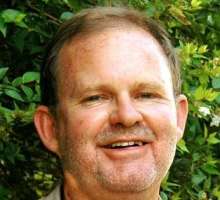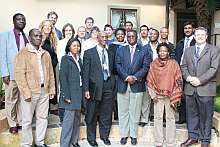SAEON gears up for action by building substantial scientific critical mass
|
- By Johan Pauw, Managing Director, SAEON
Highlights of the past two months included increasing activity in the areas of stakeholder relations and observation science as well as a successful SAEON Planning Meeting.
Stakeholder relations
Two important agreements were concluded. The first of these is a hosting agreement with Ezemvelo KwaZulu-Natal Wildlife to host the Grasslands-Wetlands-Forests Node in Pietermaritzburg. The second is an Accession Agreement for the University of Pretoria to become an official participant in SAEON.
These formal steps open the doors for various developments that will no doubt strengthen SAEON and provide concrete benefits to the partnering organisations.
Dr Amani Saidi, SAEON’s Manager of Stakeholder Relations, has initiated a project to engage intensively with SAEON partners in order to understand their business and to be able to advise on collaborative projects. His first waypoint on the project was the Council of Geosciences. He uncovered several overlapping research interests between SAEON and the Council previously not realised by both.
Education-outreach connections
On the education-outreach front, a delegation of the American Museum of Natural History visited SAEON with a view to promote their online training courses and educational resources. The potential for SAEON staff to visit the museum was also discussed.
In addition, Sibongile Mokoena, SAEON’s Education-Outreach Coordinator has established contact with the US Embassy’s Fullbright programme and is exploring the potential of exchange visits for environmental science teachers.
In yet another US connection, a new opportunity for education-outreach is taking shape in collaboration with the Global Learning and Observation for the Benefit of the Environment (GLOBE) programme. Sibongile is the National Coordinator for the programme on appointment by the Department of Science and Technology who has expressed its intention to fund the National Plan for the implementation of the GLOBE programme via SAEON. Sibongile and the three SAEON education-outreach officers participated in an international GLOBE conference in Cape Town at the end of June.
Promoting collaboration within Southern Africa
In September 2007, the SAEON Ndlovu Node hosted the annual meeting of the Environmental Long-Term Observatories of Southern Africa (ELTOSA), which produced the outline of an ELTOSA Science Plan.
Since it will still take some time for the plan to be submitted to grant-making organisations to obtain funding, SAEON decided to stimulate and award collaborative projects among individual SAEON nodes and ELTOSA sites. This will enhance ELTOSA’s status as a network organisation and should result in a few joint publications.
With this in mind, a fund has been established within SAEON to support SAEON nodes with additional funds for the purpose of bilateral collaboration with ELTOSA sites. Although preference will be given to current ELTOSA members, other Southern African countries who are prospective ELTOSA members will also qualify.
The ELTOSA Fund will support the following:
- Inter-site exchange visits and research meetings
- Research at SAEON sites
- Equipment at SAEON sites
- Publication costs of co-authored papers and other project literature
- Training by SAEON for project participants and workers
- Inter-site communication
By default this implies that ELTOSA sites seeking to partner with a SAEON node must look at covering their own costs in respect of:
- Salaries
- Local research
- Local equipment
- Local travel
- Student bursaries
- Attendance of ELTOSA meetings and relevant conferences
The budget available for each SAEON node is approximately R 80 000 per annum. Funding will be released on condition of an approved project concept and budget. As this initiative is more of a bottom-up than top-down approach, interested ELTOSA sites should contact the relevant node managers directly, and vice versa. SAEON’s rationale is that it is better to increase momentum through intra-ELTOSA success stories than through forceful programme management.
SAEON Planning Meeting
The SAEON Planning Meeting certainly moved SAEON forward in terms of its key objectives. The meeting was attended by the SAEON leadership consisting of the National Office staff, the Node Managers, Node Data Scientists and Node Education-Outreach Officers.
First on the agenda was a presentation on the implementation of the GLOBE National Plan as referred to above. The opportunity allowed for broad discussion from different perspectives and led to the development of a common understanding among participants. This was especially important for the Node Managers who will have to take responsibility at Node level.
Communication is a cross-cutting and crucial component of SAEON as a distributed organisation and hence the meeting also spent some time discussing various issues such as the frequency of the e-newsletter, the improvement of the website, e-mail protocol and so forth. The meeting also celebrated the Prism award that was made by the Public Relations Institute of South Africa (PRISA) for the launch of the SAEON Egagasini Node.
Information and data management received a fair share of time and revisited the project registration and data provider/user forms that SAEON has to implement in order to organise its information on projects and data, a substantial portion of which will be the intellectual property of others.
The roll-out of the second phase of the development of a SAEON Data Portal was discussed with specific emphasis on the incorporation of several metadata standards to facilitate multiple data providers. The applicability and advantages of the EML, Morpho, Metacat and Keplar developments were also highlighted.
Sufficient attention was given to observation science, SAEON’s core activity. A substantial background document to the development of a Core Science Plan was presented, which led to constructive discussion and contemplation.
The document pointed to the limitations of following a standard GTOS design which requires a 100-ha core site. To fulfil its mandate of observations on environmental change, SAEON’s environmental observation system must be spread across spatial scales varying from SAEON data contributing to understanding global change (e.g. global carbon budgets) through national-level (e.g. rivers, whole-ecosystem) and biome-level observations. The background document highlighted the complexity of trying to distinguish between anthropogenic change and natural variability when drivers and response mechanisms are interlinked and interchangeable.
Some key areas of investigation would have to include integrated observations across a number of biomes. These include:
- Biome shifts in response to climate change
- Degradation of rangelands
- Fire at landscape scale
- Distributional changes of species in response to climate change
- Rivers flowing through different biomes
- Atmospheric conditions and chemistry
- Physical dynamics of oceans
- Ocean-atmosphere-land interactions
SAEON’s observation system is being developed cognisant of the need to speak to international programmes and initiatives as well as the Department of Science and Technology’s Global Change Grand Challenge. Collaboration among the nodes is gaining momentum and is exemplified by the collaborative work in Algoa Bay between SAEON Elwandle and Egagasini Nodes.
The quality of the discussions at the SAEON Planning Meeting gives one confidence that SAEON has now managed to build up its own scientific critical mass and that it is in good hands. A second round of discussions on the SAEON Core Science Plan will be held towards the end of the year.












